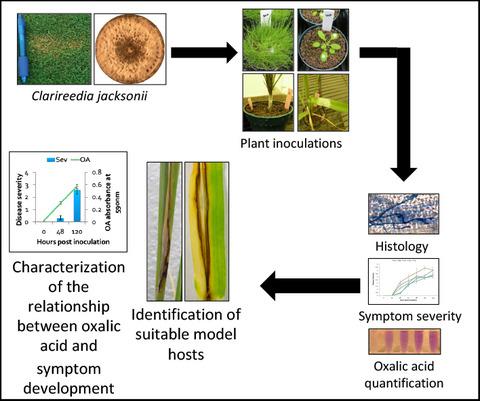当前位置:
X-MOL 学术
›
Plant Pathol.
›
论文详情
Our official English website, www.x-mol.net, welcomes your feedback! (Note: you will need to create a separate account there.)
Identification of a tractable model system and oxalic acid‐dependent symptom development of the dollar spot pathogen Clarireedia jacksonii
Plant Pathology ( IF 2.7 ) Pub Date : 2020-11-21 , DOI: 10.1111/ppa.13319 Renée A. Rioux 1 , Cameron M. Stephens 2 , Paul L. Koch 1 , Mehdi Kabbage 1 , James P. Kerns 1, 2
Plant Pathology ( IF 2.7 ) Pub Date : 2020-11-21 , DOI: 10.1111/ppa.13319 Renée A. Rioux 1 , Cameron M. Stephens 2 , Paul L. Koch 1 , Mehdi Kabbage 1 , James P. Kerns 1, 2
Affiliation

|
Clarireedia jacksonii causes dollar spot disease of cool‐season turfgrasses in the United States and produces the phytotoxin oxalic acid. The role of oxalic acid in host–pathogen interactions of C. jacksonii is unknown and there are multiple challenges to studying these interactions in natural turfgrass hosts. Consequently, identification of model plants to study C. jacksonii–host interactions and the role of oxalic acid in pathogenesis is necessary. Controlled environment inoculation assays were used to evaluate pathogenesis of C. jacksonii in various model plants and investigate the role of oxalic acid in symptom development. Observations at microscopic and macroscopic levels demonstrated that infection progressed similarly in all monocots tested (creeping bentgrass, wheat, barley, rice, Brachypodium distachyon) but not in the dicot Arabidopsis thaliana. Plant oxalic acid content increased from near zero to around 0.2–0.4 mM following inoculation with C. jacksonii in creeping bentgrass, barley, and wheat. Conversely, oxalic acid content remained near zero in A. thaliana and was not well correlated with inoculation in rice and B. distachyon, both of which had higher endogenous oxalic acid levels than other monocots. Time‐course oxalic acid quantification experiments with creeping bentgrass and B. distachyon further supported a link between symptom development and in planta oxalic acid content and identified 48 hr postinoculation as a critical time‐point for investigating the role of oxalic acid in C. jacksonii pathogenesis. These studies demonstrate that various monocots can serve as tractable model systems for studying C. jacksonii–host interactions and that increases in oxalic acid content are associated with C. jacksonii symptom development.
中文翻译:

美元现货病原体克氏梭菌的易处理模型系统的鉴定和草酸依赖性症状的发展
千里克杆菌(Clarireedia jacksonii)在美国引起凉季草皮草美元斑病,并产生植物毒素草酸。草酸在C宿主-病原体相互作用中的作用。杰克逊氏菌是未知的,研究天然草皮草宿主中的这些相互作用有许多挑战。因此,确定了要研究C的模型植物。杰克逊氏菌与宿主的相互作用以及草酸在发病机理中的作用是必要的。受控环境接种试验来评价的发病Ç。杰克逊在各种模型植物中研究草酸在症状发展中的作用。在微观和宏观水平上的观察表明,在所有测试的单子叶植物中(蠕虫,草 ,小麦,大麦,大米,短枝曲霉),感染的进展情况相似,而在双子叶植物拟南芥 中却没有。接种C后,植物草酸含量从接近零增加到0.2-0.4 mM左右。son草,ii草,大麦和小麦。相反地,草酸含量保持在接近零甲。拟南芥与水稻和B的接种没有很好的相关性。远曲,两者的内源性草酸含量均高于其他单子叶植物。bent草和B随时间变化的草酸定量实验。distachyon进一步支持了症状发展与植物中草酸含量之间的联系,并确定接种后48小时是研究草酸在C中作用的关键时间点。杰克逊病的发病机理。这些研究表明,各种单子叶植物可以作为研究C的易处理模型系统。杰克逊氏菌与宿主的相互作用以及草酸含量的增加与C有关。杰克逊氏症症状发展。
更新日期:2020-11-21
中文翻译:

美元现货病原体克氏梭菌的易处理模型系统的鉴定和草酸依赖性症状的发展
千里克杆菌(Clarireedia jacksonii)在美国引起凉季草皮草美元斑病,并产生植物毒素草酸。草酸在C宿主-病原体相互作用中的作用。杰克逊氏菌是未知的,研究天然草皮草宿主中的这些相互作用有许多挑战。因此,确定了要研究C的模型植物。杰克逊氏菌与宿主的相互作用以及草酸在发病机理中的作用是必要的。受控环境接种试验来评价的发病Ç。杰克逊在各种模型植物中研究草酸在症状发展中的作用。在微观和宏观水平上的观察表明,在所有测试的单子叶植物中(蠕虫,草 ,小麦,大麦,大米,短枝曲霉),感染的进展情况相似,而在双子叶植物拟南芥 中却没有。接种C后,植物草酸含量从接近零增加到0.2-0.4 mM左右。son草,ii草,大麦和小麦。相反地,草酸含量保持在接近零甲。拟南芥与水稻和B的接种没有很好的相关性。远曲,两者的内源性草酸含量均高于其他单子叶植物。bent草和B随时间变化的草酸定量实验。distachyon进一步支持了症状发展与植物中草酸含量之间的联系,并确定接种后48小时是研究草酸在C中作用的关键时间点。杰克逊病的发病机理。这些研究表明,各种单子叶植物可以作为研究C的易处理模型系统。杰克逊氏菌与宿主的相互作用以及草酸含量的增加与C有关。杰克逊氏症症状发展。


























 京公网安备 11010802027423号
京公网安备 11010802027423号